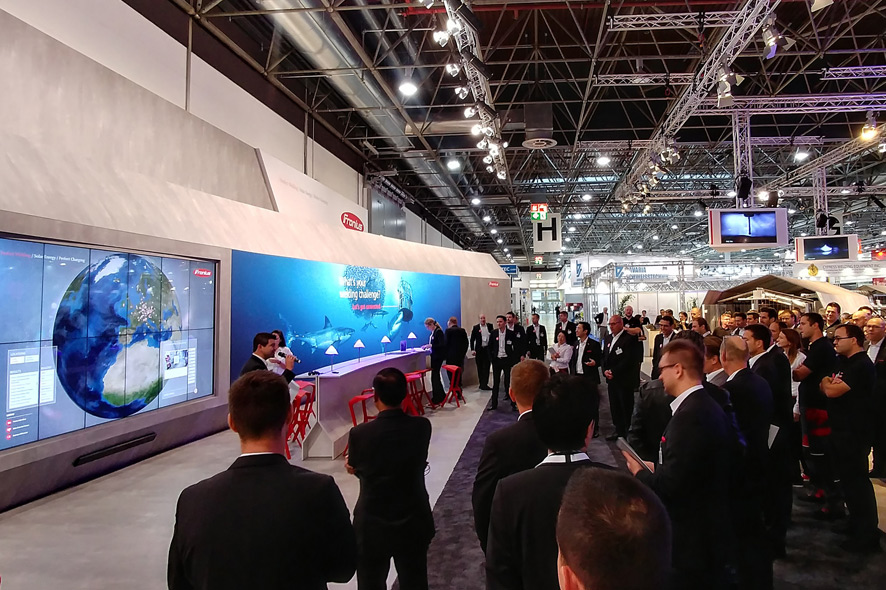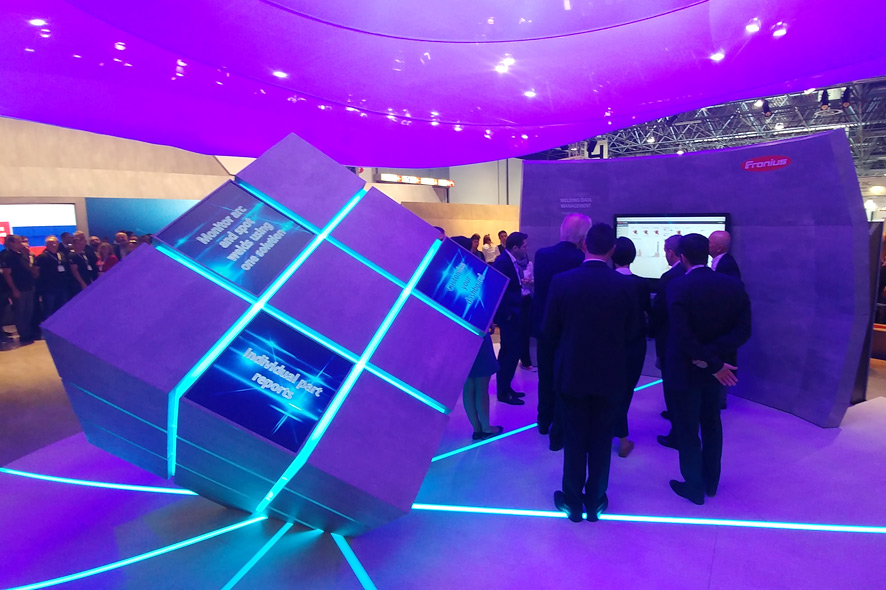Bonding materials is the objective of “Perfect Welding“ by Fronius International GmbH. In addition to photovoltaic and battery charging technology, welding is the bread and butter of this global player based in Upper Austria. So when it came to making an electrifying, high-profile appearance at the welding & cutting sector’s most important trade show, SCHWEISSEN & SCHNEIDEN (September 25-29, 2017 in Düsseldorf, Germany), Fronius turned to Ars Electronica Solutions. In this interview, Michael Mondria, director of Ars Electronica Solutions, tells us how his division carried out this assignment and discusses which architectural and interactive elements are deployed to mediate sales prospects’ encounters with content.
What was Fronius aiming to achieve when they approached Ars Electronica Solutions?
Michael Mondria: At the SCHWEISSEN & SCHNEIDEN 2017 trade show, the highest priority is obviously to effectively get across the company’s image. Thus, at the very top of Fronius’ agenda was employing state-of-the-art presentation technology to brilliantly underscore the company’s technological leadership. Accordingly, we held an initial joint workshop to elaborate on and flesh out the objectives of their trade show stand. Connection and transformation were to be the key themes; the electric arc produced by welding technology would play the featured role; and a custom-designed “solution island” would showcase the product and the systems and services that go into it. Plus, we came up with a plan for a regular series of live acts to even more aggressively attract the attention of trade show visitors. At this fair, Fronius targets a variety of groups: decision makers, shoppers, dealers, and experts in this field, so we conceived several types of communication areas in which to engage in a comprehensive dialog with a sales prospect.

Credit: Fronius
Using Fronius as an example, talk about the necessary steps in going from a concept to its implementation in the form of a trade show stand.
Michael Mondria: We divided the project into four phases. In Phase I, we began by preparing a vision paper that sketched out the basic idea and the storyline. Here, we developed an initial spatial concept, created so-called moodboards, and presented installation proposals with a rough cost estimate. Phase II consisted of several meetings and workshops attended by representatives of a few of the client’s departments at which, on the basis of the vision paper, we worked out a comprehensive, in-depth concept as well as a detailed budget. The results of this planning stage then served as the basis for Phase III, the actual production of the trade show stand. Finally, Phase IV included the installation on site and monitoring throughout the fair.

Credit: Ars Electronica Solutions / Stephan Pointner
What did Ars Electronica Solutions come up with to enable Fronius’ personnel to establish contact with prospects more quickly and to really go into depth with them?
Michael Mondria: The Fronius trade show stand is divided into several areas in which various presentation concepts are used. The centerpiece is the electric arc—which is to say the welding process per se—which is stylized as Fronius’ point of identification by establishing a connection between it and the company’s core message, Let’s Get Connected. In this way, the light phenomena produced by welding that are featured in the live presentations are channeled to and highlighted by this arc of light. Plus, the procedures being demonstrated at the live welding stations—including the analytical data generated by them—are displayed on a screen set up in the middle of the stand and in an elevated position that makes this content easily visible by all fairgoers in the area. This is augmented by a live transmission of the first-person view of the welder. The stand architecture radiating out from the arc of light takes the form of concentric circle segments, and optically extends out into the adjacent area of the building. In the form of info-screen-based product islands, we developed a uniform information delivery system for all product groups that includes product-specific presentation forms as well as additional possibilities for the individualized presentation of details. A Reference Wall displays Fronius’ worldwide distribution network on an interactive globe that can be operated intuitively and thus enables users to access information pertaining to the various individual locations. Special filters can be set up to function in both active and passive mode so the process of getting across information can be customized. A filter can be activated with respect to, for example, timeframes, geographical regions, products and applications. At stations in the Communication Area, Fronius staffers can access all information available in the system in conjunction with presentations to individual prospects or small groups of visitors.

Credit: Ars Electronica Solutions / Stephan Pointner
The two-meter-tall WeldCube was the stand’s eye-catching centerpiece. What was this all about?
Michael Mondria: At this trade show, Fronius premiered, among other products, its WeldCube, a newly developed data management system that records, analyzes and evaluates welding data. We showcased this software right beneath the arc of light in the form of a physical cube in which the streams of digital data from the individual welding stations flow together. Integrated into the cube are picture screens that make it possible to depict the object in a figurative sense as an intelligent organism. Users can select from among several modes in determining the content to be displayed on the screens, including direct visual hookups to the live welding stations. The welding procedures are visualized on the cube and enriched with the data output by the WeldCube software. For trade show visitors, this produced a direct connection among the production of the electric arc, the flow of data, and the intelligent evaluation of it.

Credit: Ars Electronica Solutions / Stephan Pointner
Ars Electronica Solutions already has several years experience in the field of trade show architecture and was honored with a Caesar Prize in this category in 2016. What are the essential elements that make for an effective presence at a trade show?
Michael Mondria: First of all, it’s important to select a motto, a message to convey and a storyline. What does the company want to get across to prospective customers? Then, on the basis of this storyline, we work together with our client to develop an architectural concept, flowing into which are new solutions and presentation techniques—some created especially for this purpose—in order to depict custom-tailored content in a way that is innovative, intuitive and transparent.
How is an exhibition actually different from a trade show stand?
Michael Mondria: An appearance at a trade show is very similar to an exhibition, but it’s considerably more compact and more challenging in several respects. In contrast to an exhibition, much less time is allowed to set up a trade show stand on site, and an exhibition’s run is normally much longer. When the task at hand is to establish contact with as many trade show visitors as possible—and thus maximize communication with prospective customers—within a few days, then sturdiness, reliability and flexibility are absolutely essential. Particularly in the case of a specialized fair, the competition isn’t far away. In a setting like this, you have to boldly convey your core message. And, of course, you should take into account the time after the trade show and consider sustainable alternative uses for this stand.

Michael Mondria is senior director of AE Solutions, a division of Ars Electronica. He studied computer science at the Johannes Kepler University in Linz and was founder and managing director of Memetics GmbH in Berlin. After 15 years working as a software engineer and manager in the multinational software company Fabasoft AG, he co-managed the Ars Electronica Futurelab for about eight years.
